
Welcome to Hyperion Records, an independent British classical label devoted to presenting high-quality recordings of music of all styles and from all periods from the twelfth century to the twenty-first.
Hyperion offers both CDs, and downloads in a number of formats. The site is also available in several languages.
Please use the dropdown buttons to set your preferred options, or use the checkbox to accept the defaults.

As in the previous sonata, the first two movements are quite short and of limited emotional range, while the third is lengthy, with several contrasting sections. This movement became so complex and filled with corrections that Beethoven wrote out a second autograph as a clean copy, though it was eventually the first autograph that was used for preparing the printed edition. A copy of this autograph was made by Wenzel Rampl, one of Beethoven’s main copyists, and after being checked by Beethoven it was sent to Paris in January 1822. A proof was checked by the composer Ignaz Moscheles as well as by Beethoven himself, and the edition finally appeared in August. Beethoven had plans for a dedicatee, and told Schlesinger that he would shortly inform them who it was to be (evidently Antonie Brentano), but he failed to do so in time and the sonata therefore appeared, unusually, without any dedication.
The opening theme is marked ‘con amabilità’ (‘with amiability’), and the whole movement is gentle and moderately paced. Even the central development section, so often a place for changes to remote keys, is calm and relaxed, and remains near the home key, although the recapitulation shifts briefly to E major, recalling the key of the previous sonata. The second movement is a stormy one in a minor key, though with a gentler middle section. It is allegedly based on two folk songs, but Beethoven’s sketches show clearly that it was not.
Several elements are combined to form the composite finale, starting with a vocal-style recitative, followed by a ‘lamenting song’ (recalling the previous sonata’s ‘song’). This gives way to a fugue that gradually builds up to an impressive climax, only to subside to an even more anguished version of the lament, marked ‘exhausted, lamenting’. The fugue then returns, initially with the theme inverted (descending instead of ascending), and marked ‘little by little reviving again’. The music does gradually revive, eventually building up to an even grander climax than before, leading to a triumphant conclusion.
from notes by Barry Cooper © 2019
Comme dans la sonate précédente, les deux premiers mouvements sont très courts et d’une portée émotionnelle limitée, alors que le troisième est assez long, avec plusieurs sections contrastées. Ce mouvement devint si complexe et plein de corrections que Beethoven coucha sur le papier un second autographe comme version propre, mais c’est finalement la première partition autographe qui fut utilisée pour préparer l’édition imprimée. Wenzel Rampl, l’un des principaux copistes de Beethoven, fit une copie de cet autographe; Beethoven la vérifia et elle fut envoyée à Paris en janvier 1822. Une épreuve fut vérifiée par le compositeur Ignaz Moscheles ainsi que par Beethoven lui-même, et cette édition finit par paraître au mois d’août. Beethoven avait prévu un dédicataire et dit à Schlesinger qu’il lui ferait bientôt savoir de qui il s’agissait (certainement Antonie Brentano), mais il ne le fit pas en temps utile et la sonate fut donc publiée, exceptionnellement, sans la moindre dédicace.
Le thème initial est marqué «con amabilità» («avec amabilité») et l’ensemble du mouvement est doux et d’un rythme modéré. Même le développement central, endroit qui donne lieu si souvent à des passages dans des tonalités éloignées, est calme et détendu, et reste proche de la tonalité d’origine, même si la réexposition passe brièvement en mi majeur, un rappel de la tonalité de la sonate précédente. Le deuxième mouvement est tempétueux dans une tonalité mineure, mais avec une section centrale plus douce. Il est prétendument basé sur deux chansons traditionnelles, mais les esquisses de Beethoven montrent clairement qu’il n’en est rien.
Plusieurs éléments contribuent à donner un côté composite à ce finale: il commence par un récitatif de style vocal, suivi d’une «complainte» (qui rappelle le «chant» de la sonate précédente). Elle fait place à une fugue qui parvient peu à peu à un sommet impressionnant pour retomber à une version encore plus angoissée de la complainte, marquée «épuisée, plaintive». La fugue revient ensuite, initialement avec le thème inversé (descendant au lieu de montant) et marqué «renaissant peu à peu». La musique renaît bien peu à peu, s’élevant finalement à un sommet encore plus grand qu’auparavant, qui mène à une conclusion triomphale.
extrait des notes rédigées par Barry Cooper © 2019
Français: Marie-Stella Pâris
Wie in der vorangegangenen Sonate sind die ersten beiden Sätze kurz gehalten und im Ausdrucksspektrum konzentriert, während der dritte lang ausfällt und Kontraste gegeneinander setzt. Der Satz geriet so kompliziert und enthielt derart viele Korrekturen, dass Beethoven ein zweites Autograph als Reinschrift anfertigte; zur Druckvorbereitung wurde dann allerdings das erste Autograph verwendet. Eine Abschrift davon fertigte Wenzel Rampl an, einer der Hauptkopisten Beethovens; Beethoven überprüfte sie, und sie wurde im Januar 1822 nach Paris gesandt. Die Korrektur übernahmen sowohl der Komponist Ignaz Moscheles als auch Beethoven selber, und im August erschien das Werk schließlich. Beethoven hatte eine Widmung im Sinn—Widmungsträgerin sollte offenbar Antonie Brentano sein—und sagte Schlesinger, dass er sie ihm noch mitteilen würde; doch tat er es nicht rechtzeitig, sodass die Sonate ungewöhnlicherweise ohne Widmung herauskam.
Das Anfangsthema ist „con amabilità“ bezeichnet („mit Liebenswürdigkeit“) und der gesamte, im Tempo mäßige Satz wirkt sanft und freundlich. Sogar die zentrale Durchführung, sonst häufig der Ort für Modulationen in entfernte Tonarten, ist ruhig und entspannt und entfernt sich nie weit von der Haupttonart; nur die Reprise wechselt einmal kurz nach E-Dur und erinnert damit an die vorangegangene Sonate. Den zweiten Satz bildet ein stürmisches Moll-Stück mit einem etwas zahmeren Mittelteil. Er soll auf zwei Volksliedern beruhen, eine Annahme, der Beethovens Skizzen deutlich widersprechen.
Das Finale setzt sich aus mehreren kontrastierenden Teilen zusammen; es beginnt mit einem Rezitativ im Gesangsstil, dem ein „klagender Gesang“ folgt—erneut muss man an die vorige Sonate und ihren „Gesang“ denken. Er weicht einer Fuge, die stufenweise auf einen eindrücklichen Höhepunkt geführt wird—allerdings nur, um sich wieder zurückzuziehen bis zu einer noch verzagteren Fassung der Klage, hier „ermattet, klagend“ bezeichnet. Die Fuge kehrt zurück, wobei das Thema zunächst in Umkehrung erklingt (abwärts statt aufwärts gerichtet); bezeichnet ist sie nun „nach und nach wieder auflebend“. Ebendas geschieht auch, auf einen noch grandioseren Höhepunkt hin, der in den triumphierenden Abschluss führt.
aus dem Begleittext von Barry Cooper © 2019
Deutsch: Friedrich Sprondel
 Beethoven: The Final Sonatas Beethoven: The Final SonatasBeethoven's final three piano sonatas in consummate performances by Melvyn Tan, here making his first solo album for Signum.» More |
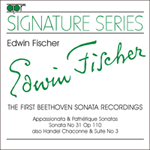 Edwin Fischer - The First Beethoven Sonata Recordings Edwin Fischer - The First Beethoven Sonata Recordings |
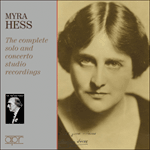 Myra Hess - The complete solo and concerto studio recordings Myra Hess - The complete solo and concerto studio recordings‘In one disc after another you are drawn towards a deeply personal quality that endeared her to thousands … this set will prompt endless reapprai ... ‘A stunning collection of music played by one of the most talented of British pianist’ (MusicWeb International)» More |
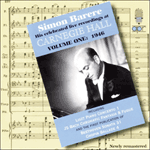 Simon Barere – His celebrated live recordings at Carnegie Hall, Vol. 1 - 1946 Simon Barere – His celebrated live recordings at Carnegie Hall, Vol. 1 - 1946 |
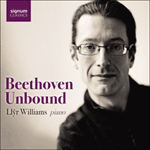 Beethoven: Beethoven Unbound Beethoven: Beethoven UnboundA comprehensive new cycle of the Beethoven sonatas recorded live at London's Wigmore Hall during the pianist's epic fourth rendition of these masterpieces .» More |
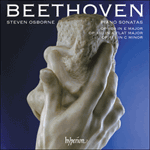 Beethoven: Piano Sonatas Opp 109, 110 & 111 Beethoven: Piano Sonatas Opp 109, 110 & 111Beethoven’s three final sonatas together constitute one of music’s great spiritual journeys, one which only a very few pianists in any age are qualified to undertake. Steven Osborne, whose Beethoven has been widely acclaimed, need fear no comparis ...» More |
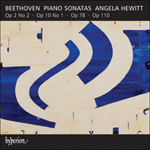 Beethoven: Piano Sonatas Opp 2/2, 10/1, 78 & 110 Beethoven: Piano Sonatas Opp 2/2, 10/1, 78 & 110Four crisp new sonatas take their place in Angela Hewitt’s ever-popular Beethoven repertoire.» More |
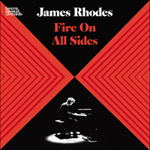 Fire On All Sides Fire On All SidesThis album was recorded to accompany James Rhodes’ new book of the same name—an intimate exploration of what it’s like to be a celebrated pianist embarking on a world tour, when you have multiple voices jostling in your head, sabotaging your happi ...» More |

